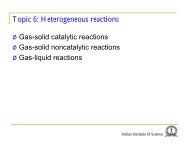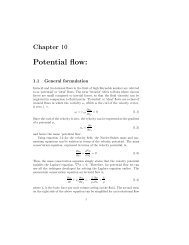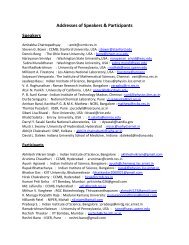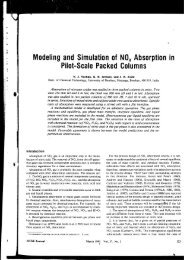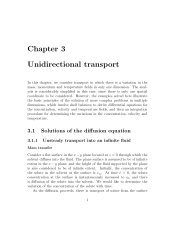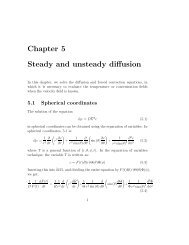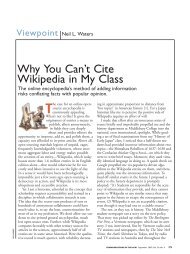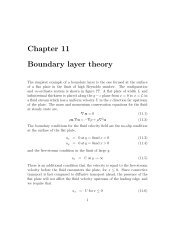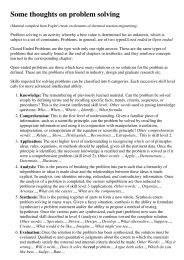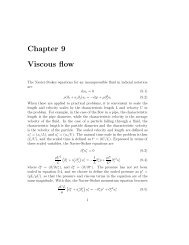Review The metabolism, pharmacokinetics and mechanisms of ...
Review The metabolism, pharmacokinetics and mechanisms of ...
Review The metabolism, pharmacokinetics and mechanisms of ...
Create successful ePaper yourself
Turn your PDF publications into a flip-book with our unique Google optimized e-Paper software.
Cell. Mol. Life Sci. Vol. 63, 2006 <strong>Review</strong> Article 835tion, ribavirin is observed not to enhance the first phasedecline in combination with interferon even when interferoneffectiveness is sub-maximal [49–51]. Thus, only aminor role – if any at all – may be attributed to a direct antiviralaction <strong>of</strong> ribavirin, such as inhibition <strong>of</strong> viral polymeraseactivity.Inhibition <strong>of</strong> IMPDHRMP can cause a depletion <strong>of</strong> intracellular GTP pools bycompetitively inhibiting the host enzyme IMPDH essentialfor the de novo synthesis <strong>of</strong> GTP [25, 52–57]. GTPdepletion may influence viral replication in two ways.First, it may inhibit viral replication because <strong>of</strong> a lack <strong>of</strong>an adequate supply <strong>of</strong> GTP required for RNA synthesis.Second, it may promote the incorporation <strong>of</strong> RTP in place<strong>of</strong> GTP <strong>and</strong> thus increase the error rate during replication,contributing to the mutagenic activity <strong>of</strong> ribavirin (see below).Whether either <strong>of</strong> these pathways significantly contributesto the antiviral activity <strong>of</strong> ribavirin remains unclear.Ribavirin <strong>and</strong> other inhibitors <strong>of</strong> IMPDH, viz., mycophenolicacid <strong>and</strong> VX-497, inhibit HCV replication inthe replicon system [17, 58, 59]. However, whereas addition<strong>of</strong> excess guanosine fully restores HCV replicationrates with mycophenolic acid <strong>and</strong> VX-497, replicationrates are only partially restored with ribavirin [48, 58,59]. Thus, <strong>mechanisms</strong> other than the depletion <strong>of</strong> GTPvia IMPDH inhibition appear to contribute to the antiviralactivity <strong>of</strong> ribavirin. Perhaps, even with an adequatesupply <strong>of</strong> GTP, incorporation <strong>of</strong> RTP in nascent RNAstr<strong>and</strong>s may occur <strong>and</strong> induce mutagenesis.ImmunomodulationSeveral studies have suggested that ribavirin has immunomodulatoryeffects [17, 25, 51], such as the abilityto induce a T h 2 to T h 1 shift in the immune response [60–62]. A T h 1 bias implies a stronger cellular rather than antibodyresponse against infection. Indeed, stronger HCVspecificT cell responses have been observed in patientsunder combination therapy than in patients under interferonmonotherapy [63], but this could be an effect <strong>of</strong> reducingviral load rather than an indication that ribavirinworks via immunomodulation.Ribavirin monotherapy does not lead to SVR [9–13]. Incombination with interferon, ribavirin does improve SVRsignificantly over that with interferon monotherapy [14–16]. <strong>The</strong>se observations suggest synergistic interactionsbetween interferon <strong>and</strong> ribavirin. However, evidence <strong>of</strong>immunomodulation by ribavirin acting synergisticallywith interferon is lacking.Loss <strong>of</strong> infected cells by immune-mediated killing isthought to underlie the second phase decline in HCVRNA (Fig. 3) in patients undergoing interferon-basedtherapy [32, 50, 51]. In some studies, ribavirin is observedto enhance this second phase decline [49, 51].Hermann et al. have recently observed a third phase insome patients, starting somewhere between days 7 <strong>and</strong> 28from the onset <strong>of</strong> therapy, in which HCV RNA decline isfaster than in the second phase [51]. <strong>The</strong> third phase declinewas faster in patients under combination therapythan under interferon monotherapy. Hermann et al. attributethis phase to a better restoration <strong>of</strong> the host immuneresponse in the presence <strong>of</strong> ribavirin. Enhancementin T cell responses leading to a greater loss <strong>of</strong> infectedcells is expected to increase HCV RNA decline in the secondphase (<strong>and</strong> third phase if present) independent <strong>of</strong> interferoneffectiveness. If ribavirin <strong>and</strong> interferon actedsynergistically, as suggested above, then the enhancementin the second phase decline would increase with interferoneffectiveness. In contrast, recent experimental observationssuggest that the addition <strong>of</strong> ribavirin enhancesthe second phase slope but only when interferon effectivenessis low [28, 50, 51]. Thus, greater evidence is requiredto establish an antiviral role <strong>of</strong> ribavirin inducedimmunomodulation.MutagenesisRNA viruses typically exist as a quasispecies – a collection<strong>of</strong> related but not identical genomes – due to theirhighly error prone replication <strong>mechanisms</strong> [64]. <strong>The</strong> existence<strong>of</strong> a quasispecies may provide the necessary diversityto the viruses <strong>and</strong> facilitate escape from specifichost-immune responses <strong>and</strong> drug therapy. However, if theerror rate during replication crosses a threshold, the quasispeciesmay be driven into an error catastrophe, resultingin a meltdown <strong>of</strong> genetic information [65–67]. Ribavirinis known to increase the error rate during viralreplication by being incorporated in place <strong>of</strong> guanosine innascent viral RNA str<strong>and</strong>s [38, 39, 68]. Thus, ribavirinmay potentially drive viruses to extinction by inducing anerror catastrophe. Even if the increase in the mutation ratecaused by ribavirin is inadequate to trigger a completemeltdown <strong>of</strong> genetic information, a higher mutation ratemay render an increasing fraction <strong>of</strong> progeny virions defectiveby compromising their ability to infect new cells<strong>and</strong>/or replicate.Several recent studies lend support to mutagenesis as thekey mechanism <strong>of</strong> the antiviral activity <strong>of</strong> ribavirin [39,68–74]. Crotty et al. have shown that mutagenesis canaccount for the entire antiviral activity <strong>of</strong> ribavirinagainst poliovirus [39]. Poliovirus lost more than 70% <strong>of</strong>its infectivity in one round <strong>of</strong> infection in vitro in thepresence <strong>of</strong> 100 mM ribavirin, which increased the mutationrate from ~1.5 mutations/genome (wild type) to~1.9 mutations/genome [39]. Higher doses causedgreater mutation; at 400 mM ribavirin the mutation frequencyincreased to ~6.9 mutations/genome <strong>and</strong> at1000 mM to ~15.5 mutations/genome [39]. A 9.7-fold in-



